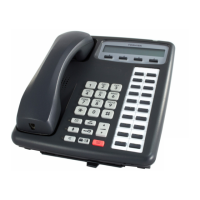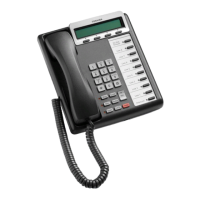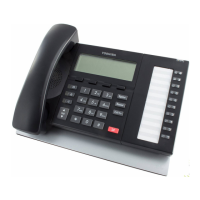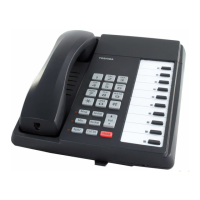DK40 Universal Slot PCBs
RBSU/RBSS ISDN Basic Rate Interface Unit
3-46
Strata DK40 I&M Manual Spring 1999
Refer to the Strata DK40 Programming Manual or DK Library CD-Rom for more details.
power to TE devices on the RBSU/RBSS transmit and receive wire pairs as shown in
Figure 3-25. This power arrangement is also known as phantom power.
Each of the four circuits on RBSU/RBSS can be connected to share the R40S using option
switches on the PCBs as shown Table 3-14. Before using the R40S as a backup power source,
you must make sure that the TE devices do not require more power than the R40S can supply
and the TE is compatible with the ISDN PS-1 power arrangement. Figure 3-25 shows the
power limits of the R40S.
Figure 3-25 Power Limits of the Backup Power Supply
RBSU/RBSS Installation
Step 1: Run Related Programs
➤ Run all ISDN programs related to RBSU/RBSS BRI circuits prior to installation of the
PCBs. This enables the circuits to operate immediately upon insertion. For further
information refer to the Strata DK40 Programming Manual.
Programming Overview
Program 03: Assign the RBSU PCB slot position (15 ~ 18), as type 78
Program *09: Assigns incoming digits to ring system groups (DDI Mode Only)
Program *10: Assigns incoming digits to ring ACD groups (DDI Mode Only)
Program *11: Assigns translation of Called Party Number (CPN) on incoming calls
Program 14-0: Assigns incoming ringing to ACD group (DEL mode only)
Program 16: Assigns the ISDN2 channels to line groups
3031
RX -
TX +
Pin 3
Pin 6
Pin 4
Pin 5
Pin 3
Pin 6
Pin 4
Pin 5
RX -
TX +
TE Device
Power sink
R40S PS-1
Power
Source
RJ-45 Pin Nos. on
RBSU or RBSS
NT circuit
RJ-45 Pin Nos.
on TE device
R40S Power Limits:
Voltage: 33.3 VDC to 38.85 VDC maximum
Current: 100mA maximum (25mA maximum per each RBSU/RBSS circuit)
TE
RBSU

